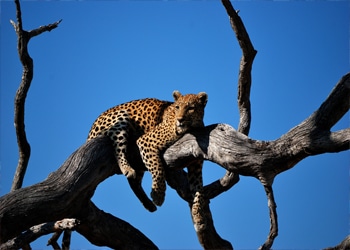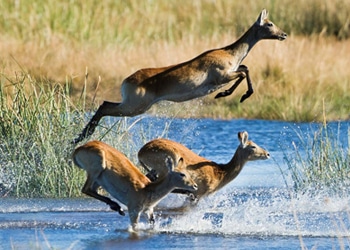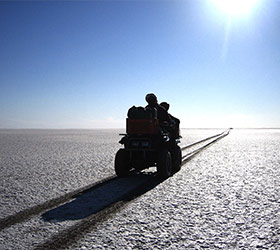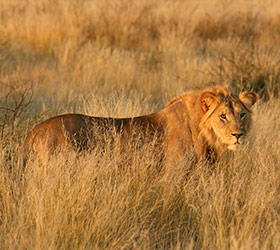Botswana
All Destinations
Botswana
With an area of almost 600,000 sq kms, Botswana is virtually the same size as France or Texas. Situated in the centre of southern Africa, it is a landlocked country, with Namibia, South Africa, Zambia and Zimbabwe as its immediate neighbours.
Outstandingly dramatic, Botswana encompasses striking salt pans, diamond-rich deserts and fertile flood plains which teem with game. A sizable proportion of the country, over 40%, is given over to National Parks, reserves and private concessions and Botswana’s policy of favouring low-impact luxury tourism ensures that even the most famous game-viewing areas rarely feel crowded.
The most striking features of the country are its flatness and aridity. With the exception of the eastern part of Botswana where the summer rainfall is slightly higher, three-quarters of Botswana is technically a desert. This is what makes the Okavango Delta even more remarkable. The largest inland delta in the world, it is a wonderful wetland within a desert, with its waters arriving from rain falling in Angola, 1,000 kms away.
In the northeast the Chobe National Park is home to gigantic elephant herds, some 500 strong. The Linyanti Reserve is characterised by open grassland, riverine forest and mopane savannas where predators such as lion, leopard, cheetah and wild dog are regularly seen.
In stark contrast to the wetlands of the Delta, the Kalahari and the Makgadikgadi salt pans offer magnificent solitude. Home to the San people, more commonly known as ‘The Bushmen of the Kalahari’, guests have the opportunity to learn about their ways, quad bike across arid pans, or witness the little-known migration of wildebeest and zebra when the pans fill with water in the rainy season.
Quick Facts
Capital
Gaborone
Population
2.25 million
Area
581,730 sq km (224,607 sq miles)
Major Languages
English (official), Setswana
Major religion
Christianity, indigenous beliefs
Currency
Pula
Flight time from London
13.5 hours via Johannesburg
Time Difference
GMT + 2
When to go
Although it straddles the Tropic of Capricorn, Botswana experiences extremes in both temperature and weather.
In the winter (late May through August), days are normally clear, warm and sunny, and nights are cool to cold. Wildlife never wanders far from water sources, so sightings are more predictable than in the wetter summer season. This is also the time of European school holidays and so some areas can be busy, especially between mid-July and mid-September and subsequently accommodation is more expensive.
In summer (October to April), wildlife is harder to spot and rains can render sandy roads impassable. This is also the time of the highest humidity and the most stifling heat; daytime temperatures of over 40°C are common.
- J
- F
- M
- A
- M
- J
- J
- A
- S
- O
- N
- D
- High Season
- Mid Season
- Shoulder Season
Highlights





Linyanti Wetlands
Bordered by the Linyanti River in the north (at the Namibian border), and the Chobe National Park in the east, the Linyanti reserve covers 1,250 km² of river, open floodplains and dense forests that protect a high concentration of wildlife. The national park only touches the river for a short section on the far eastern edge of the swamp.
One of the remotest and most inaccessible parts of Africa, the private reserve may be called a hidden paradise for safari enthusiasts. It offers more remote, private safari opportunities than the national parks allow, with walking and night drives, as well as off-road driving. Shared by a very small number of private camps, the enormous reserve is one of the least visited in Botswana, and ensures a very private and exclusive experience for those aiming to view abundant wildlife in a priviledged context.
The magnificent area boasts unparalleled wilderness with highlights of big herds of buffalo in the dry season and close encounters of unique wildlife species such as aardvark. Large herds of elephants can be viewed at the rivers and waterholes, and thousands of zebra concentrate in the winter before heading south. Other wildlife seen includes lion, leopard, cheetah, wild dog, giraffe, eland, sable, hippo, hyena, aardvark and various other nocturnal species.The endless vistas of the Linyanti marsh makes an incredible playing field for the avid bird watcher combined with breath taking views of a scenery carved by defiant forces of nature. Water birds, including pelican, are common.







Okavango Delta
The Okavango Delta (or Okavango Swamp) is formed where the Okavango River, flows from the rain-rich Angolan highlands, empties onto a swamp in an endorheic basin in the Kalahari Desert, where most of the water is lost to evaporation and transpiration instead of draining into the sea. Each year approximately 11 cubic kilometres of water irrigate the 15,000 km2 area and some flood-waters drain into Lake Ngami. The world’s largest inland delta gives birth to Africa’s largest and most beautiful oasis of lush water-wilderness. It takes the shape of a hand, with the palm permanently filled with water, and the fingertips seasonally flooded with a blue-green wilderness of fresh water, shaping million of islands and a labyrinth of papyrus-lined canals, water-lily lagoons, shady forest glades and rich savanna grasslands – an incredible source of life in a country that is 80% arid.
Sometimes dried out with salt, the islands are inhabited by hundreds of species of birds, while hippos, elephants and crocodiles move from one to another in very pure waters. From the smaller tropical fish to the larger animal, there is always something that will catch your eye and admiration, making a safari to the Okavango Delta one of Africa’s top game safari destinations. Lions, leopards, elephants and buffalos are regularly seen in the Delta – the White Rhino is more difficult to spot. The Big Five are in good company with a remarkable number of species: 164 mammal, 400 birds, 157 reptiles, 84 species of fish and 5,000 different insects.







Makgadikgadi salt pans
Measuring almost 100 feet (30 metres) deep, over an area of 30,888 sq. miles (80,000 square km), Lake Makgadikgadi began to dry up as recently as 10,000 years ago and further evaporation turned the lake into large pans with a surface glistening with salt. Today The Makgadikgadi provides one of the most dramatic African safari travel experiences.
When the summer rains fall in this region bringing life to the arid landscape and temporarily obscuring the glittering salt shine from the dry pans, an entirely different aspect of Botswana can be experienced. Fish and shrimps lying dormant in the mud wake up, flocks of flamingos and pelicans head to the area and the impressive migration of large groups of wildebeest and zebra is kickstarted. Stay in luxury safari lodges in this region and allow yourself to be guided to view some of the most exciting game watching you are ever likely to see.
The black-maned Kalahari lion and leopard stalk the empty landscapes looking for the herds of antelope that are resident here. Wild dog, cheetah and both the brown and spotted hyena also form part of the impressive array of predators in this region.
White-backed vultures, bateleurs, black-breasted snake eagles, falcons and pale chanting goshawks are just a few of the thousands of birds that are attracted by the water, fresh vegetation and new found life around the saltpans in the wet season. An excellent destination for those looking for an African birding safari, the Makgadikgadi Pans region offers a superlative experience.
Venturing far into the centre of the Makgadikgadi, on 4WD quad bikes, one can explore remote archaeological sites, periodically discovering never before documented fossil beds of extinct giant zebra and hippo. The fact that you can travel across the pans at great speed and still arrive nowhere only underlines the pans immensity (the size of Switzerland).
It is also the only place where guests able to walk through the Kalahari with a gang of habituated, but wild, meerkats!






Central Kalahari
Covering the centre of Botswana, the Central Kalahari Game Reserve, the largest game reserve in the world, has only recently been opened to the public and yet it reserved to well-organised self-sufficient groups of adventurers who can confront the remoteness, wilderness, harsh terrain and unforgiving climate. Although called a desert, the Kalahari is covered with a wide variety of habitats: sand dunes with many species of trees in the North, flat bushveld in the central area, mophane forests to the south and east, wide grasslands in vast open plains, acacia trees forrests, saltpans and ancient riverbeds…
The Central Kalahari Game Reserve was originally designed to provide a homeland for the San Bushmen, a people of nomadic hunters and gatherers who inhabited the area for the past 30,000 years. Most of them now mixed with other local tribes and live in villages or settlements in the Southern part of the reserve, and often work as guides in the desert.
The main wildlife concentrations are to be found in the northern part of the reserve; the desert truly comes to life when the summer rains (December to April) provide for green grazeland in the North: a spectacular migration then takes place, the animals congregate in large number and variety in the pans and valleys. Giraffe, wild dog, leopoard, lion, brown hyena, cheetah, warthog, a wide variety of antelope, kudu and springbok, among others, can be viewed. The visitors will also enjoy fascinating reptiles, scorpions and insects, magnificent skies at days (with impressive cloud formations during the summer rainstorms) and nights (spectacular starry skies), and the great spectacle of the Deception Valley – a 80km long ancient riverbed where mirages take place.





Linyanti Wetlands
Bordered by the Linyanti River in the north (at the Namibian border), and the Chobe National Park in the east, the Linyanti reserve covers 1,250 km² of river, open floodplains and dense forests that protect a high concentration of wildlife. The national park only touches the river for a short section on the far eastern edge of the swamp.
One of the remotest and most inaccessible parts of Africa, the private reserve may be called a hidden paradise for safari enthusiasts. It offers more remote, private safari opportunities than the national parks allow, with walking and night drives, as well as off-road driving. Shared by a very small number of private camps, the enormous reserve is one of the least visited in Botswana, and ensures a very private and exclusive experience for those aiming to view abundant wildlife in a priviledged context.
The magnificent area boasts unparalleled wilderness with highlights of big herds of buffalo in the dry season and close encounters of unique wildlife species such as aardvark. Large herds of elephants can be viewed at the rivers and waterholes, and thousands of zebra concentrate in the winter before heading south. Other wildlife seen includes lion, leopard, cheetah, wild dog, giraffe, eland, sable, hippo, hyena, aardvark and various other nocturnal species.The endless vistas of the Linyanti marsh makes an incredible playing field for the avid bird watcher combined with breath taking views of a scenery carved by defiant forces of nature. Water birds, including pelican, are common.







Okavango Delta
The Okavango Delta (or Okavango Swamp) is formed where the Okavango River, flows from the rain-rich Angolan highlands, empties onto a swamp in an endorheic basin in the Kalahari Desert, where most of the water is lost to evaporation and transpiration instead of draining into the sea. Each year approximately 11 cubic kilometres of water irrigate the 15,000 km2 area and some flood-waters drain into Lake Ngami. The world’s largest inland delta gives birth to Africa’s largest and most beautiful oasis of lush water-wilderness. It takes the shape of a hand, with the palm permanently filled with water, and the fingertips seasonally flooded with a blue-green wilderness of fresh water, shaping million of islands and a labyrinth of papyrus-lined canals, water-lily lagoons, shady forest glades and rich savanna grasslands – an incredible source of life in a country that is 80% arid.
Sometimes dried out with salt, the islands are inhabited by hundreds of species of birds, while hippos, elephants and crocodiles move from one to another in very pure waters. From the smaller tropical fish to the larger animal, there is always something that will catch your eye and admiration, making a safari to the Okavango Delta one of Africa’s top game safari destinations. Lions, leopards, elephants and buffalos are regularly seen in the Delta – the White Rhino is more difficult to spot. The Big Five are in good company with a remarkable number of species: 164 mammal, 400 birds, 157 reptiles, 84 species of fish and 5,000 different insects.







Makgadikgadi salt pans
Measuring almost 100 feet (30 metres) deep, over an area of 30,888 sq. miles (80,000 square km), Lake Makgadikgadi began to dry up as recently as 10,000 years ago and further evaporation turned the lake into large pans with a surface glistening with salt. Today The Makgadikgadi provides one of the most dramatic African safari travel experiences.
When the summer rains fall in this region bringing life to the arid landscape and temporarily obscuring the glittering salt shine from the dry pans, an entirely different aspect of Botswana can be experienced. Fish and shrimps lying dormant in the mud wake up, flocks of flamingos and pelicans head to the area and the impressive migration of large groups of wildebeest and zebra is kickstarted. Stay in luxury safari lodges in this region and allow yourself to be guided to view some of the most exciting game watching you are ever likely to see.
The black-maned Kalahari lion and leopard stalk the empty landscapes looking for the herds of antelope that are resident here. Wild dog, cheetah and both the brown and spotted hyena also form part of the impressive array of predators in this region.
White-backed vultures, bateleurs, black-breasted snake eagles, falcons and pale chanting goshawks are just a few of the thousands of birds that are attracted by the water, fresh vegetation and new found life around the saltpans in the wet season. An excellent destination for those looking for an African birding safari, the Makgadikgadi Pans region offers a superlative experience.
Venturing far into the centre of the Makgadikgadi, on 4WD quad bikes, one can explore remote archaeological sites, periodically discovering never before documented fossil beds of extinct giant zebra and hippo. The fact that you can travel across the pans at great speed and still arrive nowhere only underlines the pans immensity (the size of Switzerland).
It is also the only place where guests able to walk through the Kalahari with a gang of habituated, but wild, meerkats!






Central Kalahari
Covering the centre of Botswana, the Central Kalahari Game Reserve, the largest game reserve in the world, has only recently been opened to the public and yet it reserved to well-organised self-sufficient groups of adventurers who can confront the remoteness, wilderness, harsh terrain and unforgiving climate. Although called a desert, the Kalahari is covered with a wide variety of habitats: sand dunes with many species of trees in the North, flat bushveld in the central area, mophane forests to the south and east, wide grasslands in vast open plains, acacia trees forrests, saltpans and ancient riverbeds…
The Central Kalahari Game Reserve was originally designed to provide a homeland for the San Bushmen, a people of nomadic hunters and gatherers who inhabited the area for the past 30,000 years. Most of them now mixed with other local tribes and live in villages or settlements in the Southern part of the reserve, and often work as guides in the desert.
The main wildlife concentrations are to be found in the northern part of the reserve; the desert truly comes to life when the summer rains (December to April) provide for green grazeland in the North: a spectacular migration then takes place, the animals congregate in large number and variety in the pans and valleys. Giraffe, wild dog, leopoard, lion, brown hyena, cheetah, warthog, a wide variety of antelope, kudu and springbok, among others, can be viewed. The visitors will also enjoy fascinating reptiles, scorpions and insects, magnificent skies at days (with impressive cloud formations during the summer rainstorms) and nights (spectacular starry skies), and the great spectacle of the Deception Valley – a 80km long ancient riverbed where mirages take place.
Where to stay
These are just a selection of the properties we can personally recommend. Please get in touch to hear more about our full portfolio.
Duba Plains
Duba Plains Camp sits in the heart of the Okavango Delta. A matrix of palm-dotted islands, flood plains and woodland, the 77,000 acre private reserve typifies the region’s unique landscape and is home to one of the Delta’s finest camps.
DumaTau
DumaTau Camp is a ten-roomed luxury tented camp located in the private 125,000-hectare Linyanti Wildlife Reserve which borders the western boundary of Chobe National Park in northern Botswana.
Gomoti Plains Camp
Gomoti Plains Camp is situated in an exclusive community-run private concession on the edge of the Gomoti river system in the south east of the Okavango Delta. This stylish luxury tented camp, set under the shade of acacia trees, promises wild and pristine game viewing, both on land and on water.
Great Plains Selinda Suite
Great Plains Selinda Suite offers unparallel comfort whilst touching softly on the surrounding environment. Located within the 321,237acre private Selinda Reserve, this two bedroom suite is simply perfect if you are seeking privacy in the heart of the Okavango Delta.
Jack’s Camp
Situated in the heart of the Makgadikgadi Salt Pans, Jack’s Camp is truly like nowhere else on earth. Spectacular vistas, old-world glamour, expert guiding, incredibly friendly habituated meerkats, unique desert wildlife, and superb cuisine all come together to create an experience that is completely different to any other.
Jack’s Private Camp
Sister property to the renowned 1940’s styled Jack’s Camp, in Botswana’s Kalahari desert, Jack’s Private Camp is an Exclusive Use two bedroom canvas villa a short distance from Jack’s Camp. Designed with the charm and style of Jack’s Camp with complete flexibility to explore this extraordinary corner of Africa.
Jao Camp
Re-built in 2019 on a private island within the Jao Reserve in Botwana’s Okavango Delta, Jao Camp is considered one of Botswana’s most luxurious camps.
Khwai Tented Camp
Khwai is a private, community-run concession on the eastern border of the Moremi Game Reserve along the river Khwai. The river is the sole source of water for miles around attracting wildlife from afar. All proceeds from tourism go directly to help local people and local projects through the Khwai Community Trust.
Kwando Lagoon Camp
Kwando Lagoon Camp is perched on the banks of the Kwando River in Northern Botswana, nestled beneath towering ebony and marula trees. It is one of just two camps found within the 232,000 hectare Kwando Concession, one of the largest private wildlife concessions in Botswana.
Kwetsani Camp
Kwetsani Camp, one of the most remote camps in the Okavango, is situated on an elongated island covered with palm, mangosteen and fig trees. Depending on the water levels, Kwetsani offers excellent land and water activities, viewing wildlife by mokoro or on game drives. During times of high water, Kwetsani boats to Hunda Island for game drives, complete with a picnic for a full-day excursion.
Linyanti Bush Camp
Linyanti Bush Camp is a small, intimate 12-bedded tented camp located on the banks of the Linyanti marshes in a private reserve which borders the western boundary of Chobe National Park in the Chobe Enclave. The camp offers light, airy and tastefully furnished rooms under canvas meru-style tents.
Macatoo Camp
Macatoo Camp, the base for African Horseback Safaris, is situated on the western side of the Okavango Delta. Covering 17,000 km sq, the Okavango is the largest inland delta in the world, a mix of labyrinth channels, palm fringed islands and fertile floodplains.
Mashatu Euphorbia Villas
A private 31,000 hectare unfenced reserve with incredible vistas, unusual topography and open terrain in the most south easterly part of Botswana. The land of giants with elephant, boababs and lion, Mashatu offers an adventurous safari with walking, cycling and horse riding all available from the comfort of your luxurious Euphorbia villa.
Shinde
Nestled on a lush palm island in the heart of the northern Okavango Delta, Shinde is an intimate camp, with eight classic tents, located on the edge of the Shinde Lagoon. A complete safari experience, Shinde is an ideal base for both water and land based safari activities.
Tau Pan Camp
Tau Pan is the first semi-permanent camp inside the Central Kalahari Game Reserve and offers truly incredible views from the elevated ridge of an ancient sand dune, an unusual experience in a land as flat as Botswana, and overlooks the famous Tau Pan – recognised for its stark beauty and remoteness.
Tawana
It doesn’t get much better than waking up overlooking the Gomoti River within the wildlife rich Moremi Game Reserve as hippos wallow, lechwe leap and jacanas walk on water. Away from the crowds, this eco conscious lodge promises unparalleled exploration of the Okavango Delta.
Xigera Safari Lodge
Framing a wildlife rich floodplain and riverine forest, Xigera blends naturally with its surroundings. One of the newer, most luxurious lodges in Botswana, Xigera promises a different type of safari, where guests can shape their experience exactly as they like. “Anything anytime is possible”.
Get in touch with us now to start planning your journey
Follow Us
Proudly ASSOCIATED WITH











